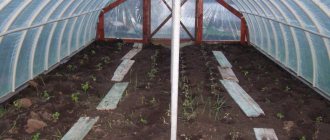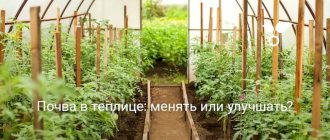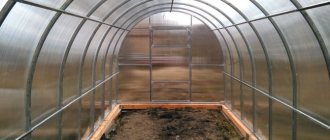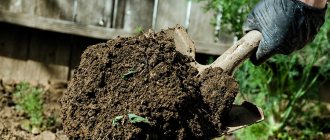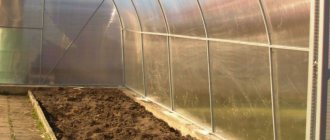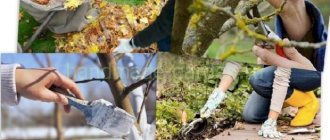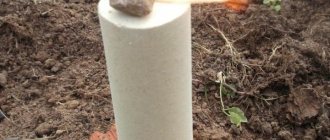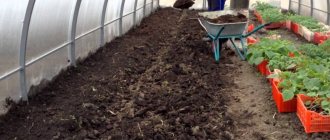What is it needed for?
Copper sulfate increases soil acidity and enriches the soil. Autumn disinfection is very useful for peat soils with copper deficiency; for chernozems, copper sulfate is recommended to be used much less frequently. Traditionally, it is used to disinfect greenhouses.
Pre-winter treatment of soil, trees and shrubs with a fungicide reduces the risk of various infections. Ridding the soil of painful spores will protect future plantings from many problems:
- root rot;
- powdery mildew;
- septoria;
- anthracnose;
- rootworm and other diseases.
Adding copper sulfate to the soil will be a good fertilizer and protect the future harvest.
Why is the soil treated with copper sulfate?
Fungal diseases, rot, rust, late blight, fusarium, and scab cause significant damage to plant crops. If the soil is not disinfected before planting, the yield may decrease significantly.
It is copper sulfate that is used to disinfect soil. The drug also effectively destroys gnawing and sucking pests and helps increase plant resistance to diseases. The activity of the substance increases in alkaline soils.
Composition and properties
The chemical formula of the popular fungicide is CuSO4×5H2O. In appearance, it is a powder of azure crystals of saturated color, odorless. Contains the following components:
- sulfuric acid residue
- water,
- copper ions.
In nature, the substance can be found in its natural form in minerals and rocks. In the full development of plants, the fungicide is necessary in small doses to resist pests. The presence of vitriol in the soil does not form toxic compounds, disinfects the environment, and eliminates foci of fungus.
Antiseptic properties of copper sulfate
- serve as protection against diseases,
- develop immunity to fungal infection,
- increase frost resistance of plantings.
The substance cannot be considered completely harmless, although the first two elements are often found and are safe in themselves. The presence of copper is beneficial only in small doses. An increase in metal ions poses a risk of toxic poisoning to humans, especially in high-temperature environments. The substance penetrates the skin
- with the absorption of sweat during plant processing;
- when consuming vegetables and fruits grown in areas with excess copper.
The safe presence of copper sulfate residue is within the range of 2-10 mg per 1 kg of product.
The accumulation of copper ions in the soil gradually changes the composition of the soil, leading to chlorosis in plantings. Products contain less protein - as a result, quality is lost. Plants weaken and do not produce a bountiful harvest. Safe tillage can be carried out no more than once every 5 years.
Copper sulfate is characterized by increased acidity. This factor should be taken into account when cultivating the soil for planting ornamental plants that do not tolerate an acidic environment - peonies, clematis, hawthorn.
The characteristics of copper sulfate are such that it can both spoil and enrich the soil. Only proper use of the drug, precautions, and compliance with the proportions in preparing the solution will benefit horticultural farms.
Precautionary measures
As you know, copper is a dangerous poison that can lead to serious intoxication of the body. Any manipulations with it should be carried out taking into account all safety measures, and be sure to wear personal protective equipment. Of course, you cannot eat or drink, smoke, etc. while working. Children, animals and people without protective equipment should not be nearby.
If the drug gets on the skin, remove it with cotton wool or a piece of cloth, and then wash it with soap and water. The eyes are also thoroughly washed with water or a 2% solution of baking soda.
If the product suddenly gets into the respiratory tract, you need to take the person into clean air and rinse your mouth with water. There must be access to oxygen.
If swallowed, you need to lavage the stomach with a 0.1% solution of potassium permanganate, drink a tablespoon of activated carbon with 200 grams of water and a saline laxative. Induce vomiting, drink a diuretic and consult a doctor.
Preparation for use
Summer residents have long known copper sulfate as the basis for Bordeaux and Burgundy mixtures. You can buy these compounds ready-made in gardening departments, but many site owners prefer to make fungicidal solutions themselves.
Preparation of Bordeaux mixture
To make the fungicide you will need:
- copper sulfate;
- lime;
- water;
- containers for diluting components and mixing.
Early treatment of plants can be carried out with a 3% composition of vitriol (300 g of copper sulfate, 400 g of lime, 1000 ml of water). A gentle method of spraying during active growth is with 1% Bordeaux mixture (100 g of copper sulfate, 100 g of lime, 10,000 ml of water).
It is recommended to stir the main components in separate containers. Prepare warm water for dissolving vitriol crystals, no higher than 50°C. It is recommended to first stir the powder in a small volume of liquid, and then gradually add water to a total of 9 liters in the container. In another bowl, dissolve lime in 1 liter of water, strain the mixture through cheesecloth.
Do not use metal utensils to avoid a chemical reaction! The container must be plastic, plastic, glass.
The vitriol solution must cool. Then it is carefully poured into a container with a lime composition. It is important not to disrupt the sequence of preparation steps in order to preserve the beneficial properties of the Bordeaux mixture.
The finished solution has a pleasant bluish color. The prepared liquid is effective immediately after mixing the components. Destroys pathogens of late blight, rust, scab, etc.
Bordeaux mixture is valued by winegrowers for the destruction of larvae and the absence of burns on plants.
Preparing the Burgundy mixture
To make a fungicidal composition you will need:
- copper sulfate;
- soda ash;
- water;
- laundry soap;
- containers for components.
In a separate container, you first need to dilute 100 g of vitriol in 5 liters of hot water. Another container is intended for mixing 90 g of soda and 40 g of laundry soap in 5 liters of water. Then the solution with vitriol should be carefully poured into a bowl with soda ash and soap. The solution should be green. After straining, it is ready for use.
Burgundy mixture is often used to process currants and gooseberries. The advantage of the composition is not only the effective destruction of spores of pathogenic fungi, but also
- in calcium content for nutrition of soil and plants;
- in a short stay on the leaves (does not stick like Bordeaux).
Treatment of soil and plants with copper sulfate without additives is done less frequently due to the risk of leaf burns. To prepare a 1% solution you will need water and copper sulfate crystals.
First, dilute 0.1 kg of dry copper sulfate in a small volume of hot water, and then add cold water to 10 liters. Before use, the solution must be filtered.
How to prepare a greenhouse made of polycarbonate and other materials for the new season after winter?
Preparation of the structure in the spring includes a whole range of activities. After winter, debris and garden tools stored in it may remain in the greenhouse, which will interfere with planting seedlings. Also, due to seasonal fluctuations in temperature and precipitation, the covering material (polycarbonate, film), foundation and supporting structures may suffer. Among other things, before planting seedlings in the ground, you need to prepare it.
Clearing the greenhouse and surrounding area from snow
Spring preparation of the greenhouse for the new season begins with snow removal. Not all gardeners and gardeners throw snow in the greenhouse, considering it a useless undertaking. Meanwhile, its melting in the spring helps saturate the earth with moisture, as a result of which it becomes loose and saturated. If you ignore this procedure, the soil will become dense and will not allow water and oxygen to pass through well. In addition, among those who have been gardening for many years, there is an opinion that melt water has a lot of useful properties.
It is recommended to add snow at the end of winter or early spring so that the pests have time to die from frost in the bare ground. What you shouldn’t do is open the doors of the greenhouse so that everything inside gets dusty. Firstly, due to strong winds, the doors may simply come off. Secondly, a wild animal can get into a wide-open room, polluting and ruining it from the inside.
Spring cleaning of the greenhouse, removal of garbage and tools stored in it
Before processing the greenhouse, you should remove any garden tools that have been left in storage that will interfere with this process. It is also necessary to dismantle the supports that prevent the roof of the polycarbonate greenhouse complex from collapsing under the weight of snow. It is not recommended to throw them away, because they will be useful in the fall when preserving the greenhouse.
Before storing wooden supports, they should be whitewashed with a solution of lime and paint glue. If they rotted over the winter, there is no point in trying to preserve what is left of them, and it is wiser to throw them away. It is recommended to send metal supports for storage treated from rust if there is any rust and painted. You can treat them with ready-made or homemade remedies according to folk recipes (lemon juice mixed with vinegar, soda, raw potatoes).
You should also remove debris (ropes, pegs with which the tomatoes were tied) and plant debris, if this was not done in the fall. As noted earlier, green biomass must be burned to prevent the spread of pests throughout the garden plot. For example, tomatoes often suffer from late blight, which can affect other crops through tomato tops.
There is no need to rush to throw away the ash remaining after burning garbage. It will become an excellent natural fertilizer. It is good to treat the soil with it before digging at the rate of 3-5 cups per 1 square meter. m. When using ash as a top dressing, you should dissolve 1 cup of powder in a bucket of water.
Removing dirt and dust accumulated over a long winter is an important stage in preparing a greenhouse for operation, even if this was done in the fall. The frame is washed with a soap solution with the addition of copper sulfate (100 g per 10 liters of water), soda or bleach (300 g per 10 liters of water), after which the remaining liquid is collected with a rag. If harmful insects were found last season, it is recommended to add a drug against this type of pest to the solution.
Polycarbonate plates are cleaned with a sponge or rag on both sides. Wash away the soap suds from the outside under strong pressure of water, and from the inside by hand. In order not to harm the soil, when cleaning, you must follow the main rule - do not allow the soap solution to get on the ground.
Repair and disinfection of structures: how to clean the walls?
The structure must be carefully examined for damage. Under the weight of snow, polycarbonate sheets may burst or bend, and the frame itself may be damaged. If this happens, it is necessary to replace the damaged elements and strengthen the base of the structure. To seal cracks in frames and transoms, sealant is used, and for minor damage to the film, adhesive tape is used.
If the green inhabitants of the greenhouse were sick last season, autumn disinfection is unlikely to help get rid of all pathogenic microorganisms, so measures to destroy the sources of disease must be taken in the spring. There are many ways to disinfect a greenhouse complex (information about them is presented in the table below). The greenhouse is treated with copper sulfate, lime, liquids based on iodine and hydrogen peroxide, smoke bombs, etc.
Tillage
Summer residents have been using this popular disinfectant for many years. In early spring, the bark of trees is treated, before buds form on the plants. This allows you to destroy harmful larvae. And the main work on soil disinfection will be done after harvesting at the end of October.
Tilling the garden in the fall is the key to successful overwintering and healthy seedlings in the spring. The effectiveness of the drug is higher when the plants are not yet affected by pathogens. The need for copper occurs during the growing season, so timely prevention will be in late autumn.
The consumption of the protective mixture is on average 10 liters per 1 m². Before starting work, the soil is first prepared for disinfection; this requires
- remove dirt, vegetation, and fallen leaves from the surface of the area;
- dig up the soil, break up the clods and loosen them;
- remove roots and weeds.
There are two ways to apply the solution to the soil:
- spray liquid;
- spill loosened soil.
Inexpensive and widespread, copper sulfate is popular among gardeners and summer residents. But being a moderately toxic substance, the drug requires precautions in use.
What is copper sulfate
A water-soluble, colorless, odorless chemical substance, copper sulfate, has disinfectant properties, is widely used in medicine as an antiseptic, and in plant growing as a fungicide. Effectively fights fungal diseases of fruit trees and rose bushes. The traditional name is copper sulfate. When interacting with enzymes of fungi and bacteria, it causes irreversible changes in the latter.
Application in horticulture
Copper sulfate is used in the garden in the fall to protect fruit trees, shrubs, flowers and soil from a number of diseases caused by the activity of microorganisms and insects. Experienced gardeners recommend autumn spraying with a solution of the drug for preventive purposes and to destroy colonies already existing on plants:
Safety precautions
The dosage of copper sulfate or preparations containing it must be followed according to the instructions. The regularity of application depends on the characteristics of the soil and other methods of disinfecting the area. Violations can negatively affect the condition of the soil, plant health and cause harm to the person himself.
Abuse leads to the following deteriorations:
- reducing the intensity of soil respiration;
- increased nitrous oxide emissions;
- difficult access to plants of necessary phosphorus and iron;
- disturbances in the interaction of micro- and macroelements of the soil;
- decreased nitrogen metabolism;
- inhibition of the activity of beneficial microorganisms and the growth of harmful organic matter.
A negative impact on humans occurs during soil cultivation without protective equipment by inhalation, i.e. by inhalation of microparticles or infection through the skin.
Copper sulfate in dry form is less toxic, the effect of the solution is more effective on human mucous membranes.
Manifestations of poisoning:
- lacrimation;
- redness of the eyes;
- development of runny nose and cough, sneezing;
- the appearance of a rash;
- chills and muscle weakness.
Necessary safety measures when working with vitriol solutions:
- When cultivating the soil, keep children and animals away;
- Carry out disinfection in calm weather at temperature conditions from 5°C to 20°C.
- Use special clothing, cover the skin and mucous membranes.
- After finishing work, wash your hands thoroughly and rinse your mouth.
- Do not pour the remaining solution into bodies of water: rivers, lakes, etc.
- Do not till the soil while plants are flowering.
The rules are simple enough to follow so as not to risk your health. If the solution gets on the skin, it is recommended to rinse with water as quickly as possible to avoid unpleasant consequences.
Do not forget that copper sulfate is a chemical substance that reacts in a certain environment. The destruction of fungal infection is the main advantage of a fungicide. Otherwise, its influence must be neutralized.
Characteristics of copper sulfate
The inexpensive drug can be purchased at hardware stores and specialized retail outlets that sell goods for summer residents. If you open the package, you can see bright blue crystals inside.
When crystals are heated, water is removed from them, and then they become light. With prolonged overheating they acquire a light gray tint. Copper sulfate does not burn, but under certain conditions it can be explosive.
Chemical features
- CuSO₄·5H₂O is highly hygroscopic (absorbs moisture);
- crystals quickly dissolve in water;
- CuSO₄·5H₂O is soluble in hydrochloric acid and alcohol.
Attention! Copper sulfate is a fairly strong poison, so it should be handled following safety rules. If ingested, it causes poisoning. Colon lavage helps.
